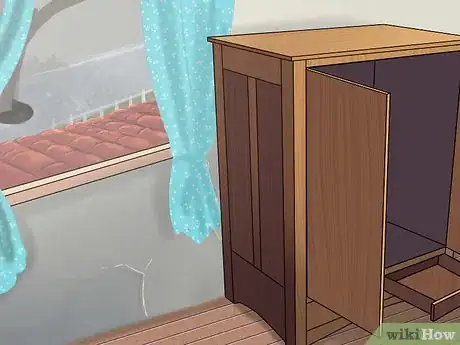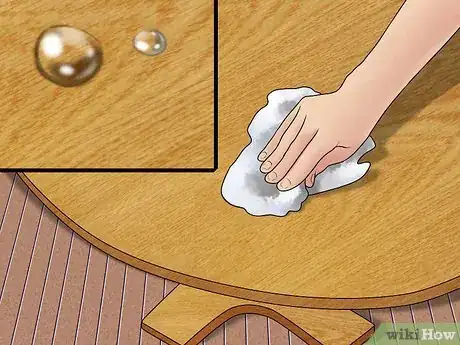This article was co-authored by William & Shannon Latil and by wikiHow staff writer, Jessica Gibson. William & Shannon Latil are Furniture Refinishing & Home Remodeling Specialists and the Founders of Furniture Refinishing Services based in Houston, Texas. With over 30 years of experience, William and Shannon specialize in repairing and restoring wood furniture, refinishing kitchen cabinets, remodeling kitchens, and building live-edge wooden tables. William and Shannon have won Awards for Excellence from the Better Business Bureau and the Houston Chronicle Best Small Business Award. Their work has also been featured in Houston Press Magazine - Kitchen Design. Additionally, the Furniture Refinishing Services team has conducted major refinishing work on venues such as NRG Stadium and Minute Maid Park.
This article has been viewed 140,789 times.
For centuries, oak has been a popular material for constructing furniture thanks to its strength, durability and beauty. Oak is known for its prominent grain which means little spots and dings just blend in. But, oak is porous so it can stain easily, especially if it doesn't have a modern finish like a glossy varnish. It can also become dry and cracked if not properly moisturized. To maintain oak furniture, you'll need to protect it from extreme temperature swings, moisture, sun and heat.
Steps
Caring For Your Oak Furniture
-
1Read the maintenance instructions. Since wood furniture that you buy has probably been treated differently, it's important to read the manufacturer's maintenance instructions. Ask for a pamphlet with care instructions when you purchase your oak furniture.
- If the furniture does not have any special instructions and has a light clear finish, follow general wood care recommendations.
-
2Air out new furniture. If your new oak furniture has been recently oiled (especially on interior and back surfaces), it might have a strong odor. To minimize this, leave any drawers or doors open to help the smell dissipate. You might want to keep windows open or run an air purifier.
- Furniture is often oiled before it is packed and shipped.
- If the smell is strong, consider placing a bowl with baking soda, white vinegar, and activated charcoal near your furniture. This can absorb odors.[1]
Advertisement -
3Sand and stain the furniture. If you're working with untreated oak furniture, you'll need to lightly sand the surface. This will smooth the furniture, ensuring that the stain goes on evenly. Take care to vacuum or wipe off all sawdust before staining. Apply your wood stain using a brush or a cloth dipped in stain. Let the stain rest before applying another coat (if you want a darker stain). There are several types of stains you can use with oak:
- Oil-based: This is a deep-penetrating stain that is permanent.
- Water-based: This is easier on the environment and easier to clean up.
- One-step stain and finish: This is a combination stain and finish.
-
4Consider stripping the wood. If the oak furniture has severe staining or you'd just like to change the look of the furniture, you may want to strip the wood. You'll need to determine what protective coverings are on the wood before you remove them. For example, if the furniture is covered in varnish, you'll need to apply varnish stripper according to the manufacturer's directions. You can then re-varnish or stain the furniture.
- Test the stripper in a small inconspicuous spot before applying it to the whole piece of furniture.
- Always wear gloves and protective glasses when using stripper. You may also want to wear old clothing when refinishing furniture.
- Stripper has really strong fumes, so you should never apply it indoors.
-
5Seal oak furniture. Oak is likely to absorb dirt if the surface is not sealed. Once you've applied stain, think about applying a finish. You can use a strong polyurethane (which is also available as a water-based poly) or a penetrating-oil finish which gives a beautiful finish. To use polyurethane, apply it in several thin coats, sanding between them. To use a penetrating-oil finish, apply the finish and let it soak in before wiping it off with a soft cloth.
- There are a variety of penetrating-oil finishes like Tung oil, Danish oil and Antique oil. These will need to be reapplied periodically (whenever the wood feels dry or looks dull).
-
6Clean the oak. If the wood has been sealed and finished, you can simply wipe it down with a clean damp cloth. Take a soft dry cloth and buff out any moisture. If the wood hasn't been sealed, clean the wood using a gentle wood oil and then apply a moisturizing polish. To protect the wood, always use soft cotton cloths and consider wearing gloves while you work.
- Avoid cleaning with common household cleaners, even if they're wood cleaners. Many household cleaners can leave behind a layer of oil that will buildup. Or, cleaners may strip your furniture over time.
-
7Moisturize your furniture. To maintain your furniture's shine and repel water, treat the wood with furniture oil, wax, or polish. Moisturize at least once a month to prevent cracking or more frequently (like once a week) if the furniture gets daily wear and tear. You may also want to oil a new or used piece of oak furniture that appears dry.
- The dryness level in wood will equal the dryness of its surroundings after a few months. It does not need and cannot be "replenished" with lots of oil, although that can make the surface prettier. Rapid temperature and humidity changes always risk cracking, and oil buildup into unfinished surfaces can make wood abnormally flammable.
Avoiding Damage to Your Oak Furniture
-
1Avoid direct sunlight and heat. Don't place oak furniture next to a source of heat or in direct sunlight. This can cause excessive dryness, difficult to fix cracks of body components, and color fading. If you must place the furniture right next to an air vent, close its louvers to reduce air flow (but don't close more than a small fraction of them all, as that could hurt the HVAC system.)
- Keep your oak furniture inside. Unless specifically designed for outside use (such as regularly cleaned and oiled deck chairs), wooden furniture should always be used inside.
-
2Clean up spills. Always clean spills and water off of oak furniture. Since oak is porous, it will easily soak up water. This can damage the finish and lead to staining. Wipe up spills with a clean dry cloth or paper towel.
- The longer a spill sits, the deeper the spill can penetrate. This is why it's important to dry a spill as soon as you notice it.
-
3Move all furniture carefully. No matter how strong and sturdy oak furniture looks, always move it with care. To do so, lift it or gently push it with sliders and rollers. Carefully set it down to preserve the integrity of the joints. If a joint does come undone, it can usually be fixed with glue and a clamp.
- Never drag furniture by it's legs or pull it across a room.
-
4Protect the finish. Don't expose oak to strong cleaning agents, coffee, wine, water or other liquids. Modern finishes can generally be cleaned with a damp (not soggy), lightly soaped towel. Antique finishes can be more delicate, so test an inconspicuous area and wait a few minutes to see what happens before proceeding.
- Avoid putting hot items such as dishes or pans directly on the wood. Instead, use trivets or heavy mats.
-
5Repair any dents or marks. You may be able to repair slight damages to oak furniture. You can use furniture markers and putties (available in a variety of colors) to fix small chips. To repair a mark or dent in unfinished furniture, try swelling the ding back out. Put a damp cotton cloth over the spot and place the tip of a warm iron onto the cloth so the wood rises up. Once the blemish is dry, sand it down with a fine-grain sandpaper, then oil it.
- Furniture oil tends to darken light dings in overall hard finishes. Use the "natural" yellowish kind for a medium brown color. If you need nearly-black, try dark furniture oil. Don't soak too much oil into a waxy-type finish since it can really stain.
- Some putties harden while others stay soft and removable. For penetrating fixes start with lighter tones.
Community Q&A
-
QuestionI have a light oak table with a large stain slightly darker than the surrounding bare wood. Is there a wood finish that will even out the color?
 Community AnswerNo, don't use a wood furnish, because it will simply varnish the table, making it hard for you to cover over. Instead, use a walnut and "color" over the stain, as if the walnut were a crayon. If this doesn't work try asking a professional.
Community AnswerNo, don't use a wood furnish, because it will simply varnish the table, making it hard for you to cover over. Instead, use a walnut and "color" over the stain, as if the walnut were a crayon. If this doesn't work try asking a professional. -
QuestionWhat is the best oil to use on oak?
 Community AnswerUse mayonnaise. It's excellent for bringing out water marks and makes your untreated oak look like new.
Community AnswerUse mayonnaise. It's excellent for bringing out water marks and makes your untreated oak look like new. -
QuestionWhat kind of oil should I use to take care of oak furniture?
 Community AnswerSeal oak furniture. Oak is likely to absorb dirt if the surface is not sealed. Once you've applied stain, think about applying a finish. You can use a strong polyurethane (which is also available as a water-based poly) or a penetrating-oil finish which gives a beautiful finish.
Community AnswerSeal oak furniture. Oak is likely to absorb dirt if the surface is not sealed. Once you've applied stain, think about applying a finish. You can use a strong polyurethane (which is also available as a water-based poly) or a penetrating-oil finish which gives a beautiful finish.
Warnings
- Oily rags can spontaneously combust. Dispose of them in a metal container away from flammables.⧼thumbs_response⧽
- If you oil surfaces that will be sat on or have cloths on them, allow plenty of time for drying so you don't damage the fabric.⧼thumbs_response⧽
References
About This Article
Maintaining your oak furniture is relatively easy and keeps it looking beautiful. If your furniture has been sealed and finished, just buff it with a damp cloth to keep it clean. Avoid cleaning with common household cleaners, even if they're wood cleaners, since these can leave oil residue. If your wood's not sealed, clean it with a gentle wood oil. You should also wipe your wood with a furniture oil, wax, or polish once a month to keep it shiny. Always use soft cotton cloths to protect the wood surface. Avoid keeping your oak furniture in direct sunlight or next to a heat source, since this can damage the wood over time. If your wood gets scratched, use a furniture marker or putty to cover it up. For more tips, including how to seal untreated oak furniture, read on!



































































